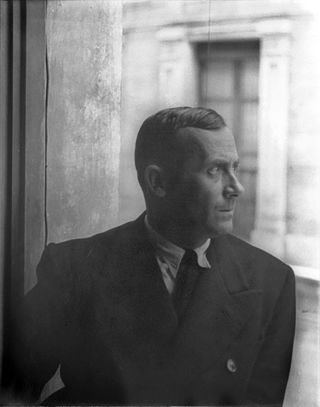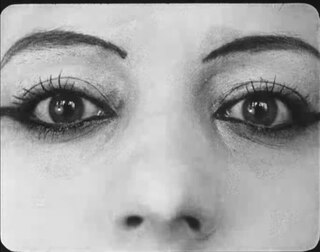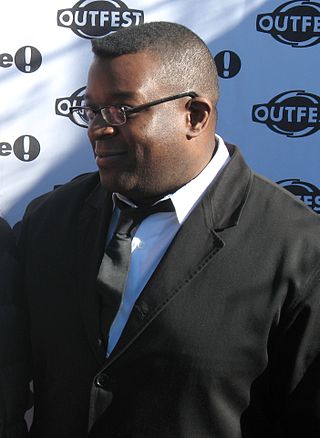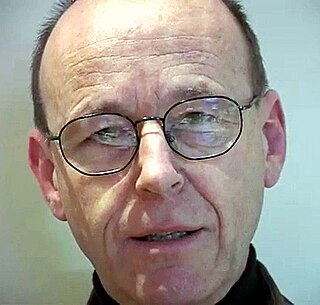
Malcolm Le Grice (born May 1940, [1] in Plymouth, United Kingdom) is a British artist known for his avant-garde film work.

Malcolm Le Grice (born May 1940, [1] in Plymouth, United Kingdom) is a British artist known for his avant-garde film work.
The British Film Institute claims that he "is probably the most influential modernist filmmaker in British cinema". [2]
Le Grice was born in 1940, and studied at Slade School of Art, London. He founded the London Film-Makers' Co-op workshop in the late 1960s, at the same time introducing film to fine art students at Saint Martin's School of Art and Goldsmiths College, London. He has balanced his continuing practice as a filmmaking artist with campaigning for the artform in print, in higher education, and in committees at the British Film Institute and the Arts Council.
Le Grice started as a painter but began to make film and computer works in the mid 1960s, [3] becoming a pioneer of computer-generated filmmaking. [4] Since then he has shown regularly in Europe and the US and his work has been screened in many international film festivals, including recent retrospectives at Media City Film Festival (2015) and RedCat in Los Angeles (2019). He has also shown in major art exhibitions like the Paris Biennale No.8, Arte Inglese Oggi, Milan, Une Histoire du Cinema, Paris, Documenta 6, Kassel, [5] X-Screen at the Museum of Modern Art, Vienna, [6] and Behind the Facts at the Fundació Joan Miró, Barcelona. [7]
His work has been screened at the Museum of Modern Art, New York, the Louvre Museum in Paris and the Tate Modern and Tate Britain in London and is in permanent collections including: the Centre Georges Pompidou, Paris; the Royal Belgian Film Archive, Brussels; the National Film Library of Australia, Canberra; German Cinamatheque Archive, Berlin; Canadian Distribution Centre, Montreal and Archives du Film Experimental D'Avignon. A number of longer films have been transmitted on British TV, including 'Finnegans Chin', 'Sketches for a Sensual Philosophy' and 'Chronos Fragmented'. His main work since the mid 1980s is in video and digital media and includes the multi-projection video installation works 'The Cyclops Cycle' and 'Treatise'.
Le Grice has written critical and theoretical work including a history of experimental cinema 'Abstract Film and Beyond' (1977, Studio Vista and MIT). For three years in the 1970s he wrote a regular column for the art monthly Studio International and has published numerous other articles on film, video and digital media. Many of these were collected and published under the title 'Experimental Cinema in the Digital Age' by the British Film Institute (2001). Le Grice is a Professor Emeritus of the University of the Arts London. [8]

Joan Miró i Ferrà was a Catalan Spanish painter, sculptor and ceramist. A museum dedicated to his work, the Fundació Joan Miró, was established in his native city of Barcelona in 1975, and another, the Fundació Pilar i Joan Miró, was established in his adoptive city of Palma in 1981.

David Hall was an English artist, whose pioneering work contributed much to establishing video as an art form.

Experimental film or avant-garde cinema is a mode of filmmaking that rigorously re-evaluates cinematic conventions and explores non-narrative forms or alternatives to traditional narratives or methods of working. Many experimental films, particularly early ones, relate to arts in other disciplines: painting, dance, literature and poetry, or arise from research and development of new technical resources.

Sir Isaac Julien is a British installation artist, filmmaker, and Distinguished Professor of the Arts at the University of California, Santa Cruz.
The London Film-makers' Co-operative, or LFMC, was a British film-making workshop founded in 1966. Its annual BFI Regional Film funding as a Limited Company and Registered Charity was withdrawn in 1999, without notification of its membership. The Arts Council of England sought to force the amalgamation of the London Film-makers Co-operative Distribution Archive with London Electronic Arts formerly London Video Access to form Lux Ltd. In less than one financial year the limited company set up by the Arts Council went into liquidation, resulting in the sale of its assets by Price Waterhouse Cooper. London Film-makers Co-op life members with legal advice gathered together proofs from key members including founder members of donated items of workshop and film projection equipment. With legal documentation those items were successfully withdrawn from the Price Waterhouse Cooper sale. However the Arts Council refused to release the contact details of over 200 members so that an urgent General Meeting could be called to prevent the unlawful confiscation and retention by the Arts Council of England and its paid appointees, of the Distribution Archive collection and the film processing, printing, editing and cine projection equipment.LUX.
Günter Brus was an Austrian painter, performance artist, graphic artist, experimental filmmaker, and writer.

The Fundació Joan Miró is a museum of modern art honoring Joan Miró located on the hill called Montjuïc in Barcelona, Catalonia (Spain).

Anthony McCall is a British-born New York based artist known for his ‘solid-light’ installations, a series that he began in 1973 with "Line Describing a Cone," in which a volumetric form composed of projected light slowly evolves in three-dimensional space.

Jackie Hatfield was an artist, writer, and academic. According to the influential artist-led no.w.here website: "Jackie Hatfield is an artist and writer who makes expanded and participatory cinematic artworks using digital video, performance, sound and digital print. She has co-edited two critical books around women's use of technology in art practice and has published essays that concentrate on under-explored histories of experimental film and video practices."

Eyal Sivan is an Israeli documentary filmmaker, theoretician and scholar based in Paris, France.

Chris Welsby is a Canadian experimental filmmaker, New Media and gallery installation artist. Born in the UK, in the 1970s Welsby was a member of the London Film-Makers' Co-op, and co-founder of the Digital Media Studio at the Slade School of Fine Arts, UCL, London. He immigrated to Canada in 1989. He is considered one of the pioneers of expanded cinema and moving image installation and was one of the first artists to exhibit film installations at the Tate and Hayward galleries London. His expanded cinema works and installations have since continued to break new conceptual ground and attract critical attention. A. L. Reece, in British Film Institute's A History of Experimental Film and Video, wrote: "Twenty-five years ago, when he made his first projections for large spaces, film and art rarely met in the gallery; now it is common and installation art is a distinct practice."
Paintings on masonite is a series of 27 abstract paintings made by Joan Miró using the type of proprietary hardboard known as masonite, just after the Spanish Civil War started on 18 July 1936. These works break with his earlier phase which was known as his wild paintings period. This was a label established to describe the work done during the two years preceding the Civil War, between 1934 and 1936.
Non-narrative film is an aesthetic of cinematic film that does not narrate, or relate "an event, whether real or imaginary". It is usually a form of art film or experimental film, not made for mass entertainment.
Marcus Coates is a contemporary artist and ornithologist living in London. His works, including performances and installations that have been recorded as video art, employ shamanistic rituals in communication with "the lower world", and contrast natural and man-made processes.
Tina Keane is a British artist who has worked with film, video, digital media, and performance, and been a forerunner of multimedia art in the UK. Reflecting a feminist perspective, her works have often explored gender roles, sexuality, and political concerns. She has stated that her work is primarily about "identity and play".
Sarah Pucill is a London-based film artist. Her work is distributed by LUX, London and LightCone, Paris. She is a Reader at University of Westminster. Central to her work is "a concern with mortality and the materiality of the filmmaking process". Much of her work appears within the restrictions of domestic spaces. In her "explorations of the animate and inanimate, her work probes a journey between mirror and surface".

Nalini Malani is an Indian artist, among the country's first generation of video artists.
John Menick is an American artist and writer working primarily in the moving image, fiction, and essay form.
Adam Finch is a British film editor whose work spans drama, documentary and the arts. He is best known as the editor of the surreal mystery film Innocence, and for his multi-screen editing for filmmaker and installation artist Isaac Julien.